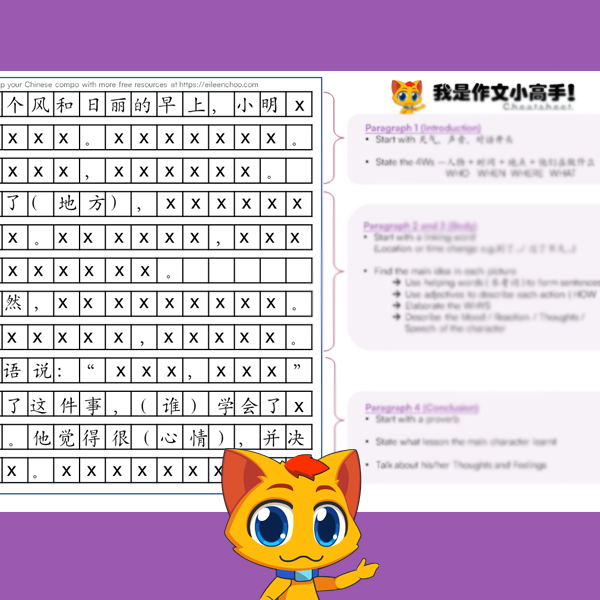What is Chinese comprehension?
Chinese comprehension, or 阅读理解 (yue4 du2 li2 jie3), can come in many forms. In Singapore primary school, students are given a set of text that can come in the form of advertisements, letters or narrative passages and expected to comprehend its content and answer a set of questions that comes with them.
The Chinese comprehension questions can come in two forms – multiple-choice-questions (MCQ) and open-ended (the kind where our kid needs to phrase their own answers).
If you ask any primary school kid about the component that they dread most, you’ll probably hear “Chinese compre” popping up most of the time (besides “Chinese composition!). So why are most kids resistant to them?
Why kids find Chinese comprehension tough
Most kids are weak in Chinese comprehension and that’s understandable because Chinese compre is a test of many skills
As Chinese name for comprehension goes, 阅读理解, 阅读 means reading in Chinese and 理解 means understanding. Hence, to be good at Chinese comprehension, a kid has to be good in multiple areas – reading, understanding, writing and expressing.
1. Comprehension in Chinese vs English
Let’s start with the 阅读 part, which is essentially reading the Chinese passage.
Before answering any Chinese comprehension question, the first hurdle that our kids have to cross is to understand what they’ve read in the Chinese comprehension passage. Whether your child is able to overcome this “comprehending” phase depends on 2 important factors – the number of Chinese words that they can recognise and their patience.
How many Chinese characters can your kid recognise?
Unlike English comprehension where most children in Singapore have no problems reading, the Chinese comprehension passages have an added layer of difficulty because our kids need to be able to recognise the Chinese characters first before they can even read and understand them.
How patient is your kid at reading the Chinese passage?
This determines how much of the Chinese passages your child reads and how accurate their understanding is.
Since most Chinese comprehension passages can be quite long, some kids may start skimming through them. This might cause them to miss out on important points or jump to conclusions about what they have read. As a result, they might answer the comprehension questions incorrectly.
This is the 理解 part.
2. Answering the Chinese comprehension questions
Next comes the Chinese comprehension questions. When it comes to answering this questions, there are another 2 hurdles to cross.
Understanding what is asked
If your kid misunderstands the comprehension questions, they might write answers that are out of point.
Being able to express themselves correctly
To ensure that your kid answers the compre questions correctly, they need to be able to express their thoughts accurately in Chinese. Kids who are weak in Chinese often find this hard and end up writing some sentences that don’t reflect their thoughts correctly.
Which of these difficulties is your kid facing when they are doing their comprehension practices?
Now that we’ve identified the common problems that kids have with Chinese compre, let’s look at what parents can do to help them improve their Chinese comprehension.
5 Tips to improve Chinese Comprehension
Here are 5 tips that I often share with parents to help improve their kid’s Chinese reading comprehension skills. The good news is, you don’t have to put them through multiple drills to be good at it. Incorporating these into your child’s daily routines will be more than enough to help them get better.
1. Practise reading Chinese with the Chinese textbook your kid uses in school
Sounds simple? It is!
How this helps your child understand comprehension passages better
Your kid is already studying their 欢乐伙伴 (huan le huo ban) Chinese textbook in school. Since the textbook contains all the essential vocabulary for your kid’s current primary school level, you might as well make full use of it.
Being able to read all the Chinese characters in your school textbook would mean that your child will have no problems reading 99.9% of the the characters that appear in the Chinese comprehension passages.
What can you do if your child is unable to recognise the Chinese words and characters at their level? You can start with the Chinese textbook that they’ve used the previous year to make it easier.
Getting your child to read a textbook that is one level lower will not only help them revise the words that they’ve missed out, but also help them builds up their confidence in the Chinese language over time. Once they are ok, you can then switch the Chinese textbook back to the current one that they should be using.
2. Watch Chinese cartoons / animes / drama with Chinese subtitles
This fun method requires no effort but works wonders. The best part, your kid will love it!
This is a tested and proven method tried. I’ve seen multiple students improving drastically by doing this (and it’s also my little secret of how I became good at Chinese myself)
How this helps your child read better
Don’t be mistaken that watching tv has no value. As our kids watch these Chinese cartoons, animes or drama, we’re trying to make them get used to how the Chinese language is being used in different contexts.
While they watch and hear how the characters speak or read the Chinese subtitles, they are also subconsciously revising the Chinese characters that they’ve already learnt in school and picking up new Chinese characters.
Over time, this accumulation of Chinese vocabulary will help them understand what they are reading in the comprehension passages better, boosting their comprehension skills.
Here are some suggestions of good quality and educational ones that I use in school:
3. Read Chinese comics or Chinese-translated Japanese mangas to improve your reading skills
We don’t want our kids to keep looking at the screen all the time.
Another way to help them improve their Chinese comprehension skills offline is to get them used to reading Chinese text.
This can be in the form of Chinese comics or Chinese-translated Japanese mangas. You can also try Chinese storybooks if you want, but from experience, I realised that kids are more resistant to these, so start small.
How this helps your child’s comprehension skills
There are many benefits to reading Chinese comics or Chinese-translated Japanese mangas and there’s actually a good variety that caters to the interests of kids. Since the dialogues are often short and easier to digest, kids focus better and this trains their patience indirectly.
As our kids are reading, they are also learning how to infer the meaning of unfamiliar words from the context (the keywords and phrases) within the story. Once they master this powerful skill, they can apply the exact same skill to decipher the difficult words they see in their Chinese comprehension passages in school.
Here are some recommendations of the starter comics I used with my primary school kids. You can get these reading resources quite easily at Popular bookstore:
4. Read Chinese storybooks
If you ask any Chinese teacher what’s the best way to improve Chinese, I’m sure they’ll tell you to ask your child read Chinese books, but personally, I feel that this is one of the last things you should do unless your child is already super enthusiastic about Chinese.
Reading Chinese books sounds good in theory, but it’s hard to get your child to do it in real life.
However, should your child be open to it. Here’s what I can advise:
First, pick the right Chinese storybooks that are suitable for your child’s reading level. Don’t buy the books according to any recommended Chinese storybooks list. Most of these lists are imagined according to the average standard of Chinese that a primary kid should have but we all know that each kid is different.
Instead, get your own kid to choose.
This will ensure that the storybooks appeal to their interests. It doesn’t matter if they choose those with simpler language or those that come in pinyin, the goal is for them to keep reading and persist even if there are a few new Chinese characters here and there that they don’t recognise. Don’t make them feel overwhelmed. Them picking up a Chinese storybook is already much better than none at all.
5. Use daily conversations to practise answering Chinese comprehension questions
Before you imagine it as a Q and A session with your kid, the idea is not to be mechanical about it.
Create opportunities for your child to practise answering questions in Chinese by asking them casual questions like how’s their day in school (你今天在学校好吗?)or what they have done (今天在学校做了什么?)in Chinese and hear what your kid has to say.
The goal here is to encourage them to answer in Chinese so that they can practise their answering skills and express themselves better using the language.
Don’t expect them to answer you in full Chinese at the start. It’s ok if they answer in English and mix in a few Chinese words. It’s already more Chinese than what they usually speak. Do it in moderation.
If your kid gets stuck while answering you in Chinese, be encouraging and teach them the right way to answer or find out how to do that together. This can be a family bonding activity.
Speaking works just as well as writing and it’s thrice as fun! I’m sure your child would be happier sharing their interesting stories with their beloved mum/dad rather than answering boring Chinese comprehension practice questions! ;p
Conclusion
I hope this post has given you a better understanding of Chinese comprehension and sparked some ideas that you can use to help your child improve their Chinese comprehension skills.
Check out these other posts on to learn how to do better for your Chinese composition or oral exam if you are aiming to improve your Chinese in primary school.




